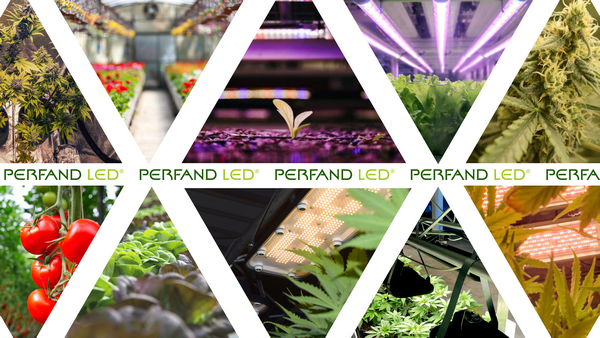There are many factors that influence the amount and length of light exposure plants receive. Things like the time of year, weather conditions, overlapping leaves, and even the position of individual plants all play a role. It’s in response to these phenomena that Perfand LED came to create technology imitating nature based on the modulation of light with a spectrum suitable for the crop. The unique pulsed lighting system for plants; the Horti 2 line.

The role of light
Light plays an essential role in the life and development of plants, with photosynthesis being essential for growth. Without it, organic compounds, which are the plant’s main source of nutrition, i.e., glucose and oxygen, are not produced. Unfortunately, the days are shorter in autumn, winter, and spring, resulting in less light for the plants.

“The use of a luminaire emitting pulsed light provides a periodic reduction in intensity, which allows the photosynthetic apparatus (chloroplasts) of the plant to be relieved for a bit, just like in nature. This ensures the plant is better prepared to receive and make effective use of light of higher intensity. Think of it as the ‘energy management’ of the plant becoming more efficient,” says Izabela Bybel- Spalinska of Perfand LED.
The main objective of the pulsed method is for the chloroplasts to absorb as much light as possible while minimizing stress levels. As Perfand LED states, their intention is to optimize the radiation crops are subjected to, and the design of the Horti LED lamps for plant cultivation enables light to be emitted with an optimum optical spectrum composition for the plants.

Horti 2 luminaires
Every plant needs light, but different species require different amounts of light. Therefore, the placement, height, and amount of lamps is important to provide the optimum amount of light.
“The Horti 2 series consists of luminaires technically designed for different types of cultivation such as indoor, growbox, vertical, hydroponic, and aeroponic cultivation. The main criterion for introducing diversity in our range is the luminous flux and spectrum. Each of the luminaires has the possibility of freely selecting the spectrum depending on its intended use. Horti luminaires provide visually white light that is safe for the eyes. However, they are enriched with LEDs with colors that correspond to the needs of the plants for which they are intended. In total, we have developed three types of spectrum based on the latest scientific research as well as consultation with specialists,” Izabela says.
The types of Horti 2 luminaires currently available are:
- Horti 2 – designed to illuminate greenhouse crops, with a power of: 200 W / 20 W.
- Horti 2 VT – designed to illuminate vertical crops. The set consists of 10 tubes with a combined power of: 265 W / 35 W.
- Horti 2 LN – a linear luminaire designed to illuminate Cannabis crops. Thanks to its design, the luminaire is also available in a set of four. Power of a single luminaire: 200 W / 20 W.
- Horti 2 SQ – designed to illuminate greenhouse crops, growboxes, and potted plants. The luminaire also comes in a set of four. Power of a single luminaire: 100 W / 20 W.

“Horti luminaires have a patented light modulation system, making them more economical compared to lamps made with traditional LED technology. Thanks to continuous pulsation, the average power of the luminaire is 100W, which generates very low lighting costs,” says Izabela.
According to Perfand LED, the use of the luminaire’s pulsed luminous flux guarantees large savings in electricity consumption of over 50% compared to fixed LED lighting while stimulating plants to increase growth.

Research on the pulsation method
Since Perfand LED is aware of the fact that the pulsation method they developed is unique, one of the most important aspects of development was to document the results and make the advantages of the luminaires real and measurable.
“The development of the pulsed lighting technology was preceded by research at the Institute of Plant Physiology of the Polish Academy of Sciences in Kraków. The research was conducted by Dr. Anna Janeczko and Dr. Monika Kula-Maximenko. The plants in their research are illuminated with 2x400W HPS lamps, an 80W LED fixture with constant light flux, and a 200/30W LED fixture (average power 90W) with light modulation. In all three experiments, the average light flux on the plants was 250µmol,” Izabela states.

Some of the advantages of the pulsation system that were found in the research carried out in cooperation with the Institute of Plant Physiology of the Polish Academy of Sciences and from the opinions of growers who have tested the technology were as follows;
- The light conditions provided by the LED lamps tested stimulate the development processes of the plants;
- The final plants tested had a higher weight and a significantly darker color, indicating a higher accumulation of assimilates;
- Very good rooting of the cuttings was also observed;
- Growers emphasize that the pulsed nature of the light and the white color of the light allows workers to work freely and unencumbered in the irradiated facilities;
- The pulsed light patented by Perfand LED is more effective than the constant LED light and the traditional light provided by HPS;
- The energy-efficient LED modules allow a significant reduction in electricity costs.
“But we are not done yet. We constantly extend our research and aim to have new products researched and tested by lighting professionals as well as users since those opinions and reviews are what will be at the foundation of our next products and developments,” Izabela concludes.
For more information:
Izabela Bybel- Spalinska, Horti Market Manager
PERFAND LED
Str. Ledowa 1
55-100 Trzebnica
Tel.: +48 727 960 100
Email: i.bybel@perfandled.pl
https://perfandled.pl/en/homepage-en/
